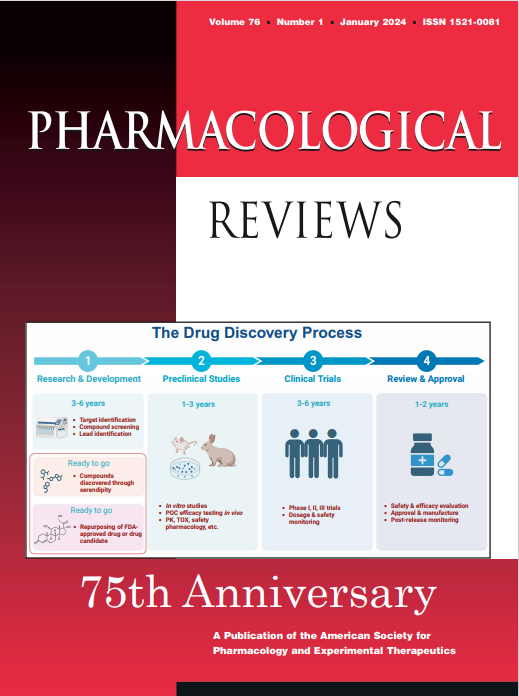醋酸格拉替雷治疗多发性硬化症:从第一代疗法到免疫调节和修复的阐明
IF 17.3
1区 医学
Q1 PHARMACOLOGY & PHARMACY
引用次数: 0
摘要
多发性硬化症(MS)是中枢神经系统(CNS)的一种慢性炎症性脱髓鞘和神经退行性疾病,可能源于自身免疫,发病机制复杂。20 世纪 90 年代,随着第一代疾病修饰疗法的开发,通过减少复发和减缓残疾累积来改变多发性硬化症的自然病史的目标首次实现。醋酸格拉替雷(GA)是一种由L-丙氨酸、L-赖氨酸、L-谷氨酸和L-酪氨酸组成的共聚物,因其能够抑制多发性硬化症的动物模型--实验性自身免疫性脑脊髓炎而被发现。广泛的临床试验和长期评估证实了 GA 的有效性和安全性。此外,对 GA 在动物模型和多发性硬化症患者中诱导的治疗过程的研究表明,GA 会影响先天性和适应性免疫反应的不同水平,产生从促炎到抗炎途径的偏差。这包括与抗原呈递细胞竞争结合;促使树突状细胞、单核细胞和 B 细胞产生抗炎反应;以及刺激 T 辅助 2 细胞和 T 调节细胞。受 GA 刺激的免疫细胞进入中枢神经系统,并在原位分泌抗炎细胞因子,从而缓解病理过程。此外,累积的研究结果表明,除了免疫调节作用外,GA 还能促进神经保护性修复过程,如神经营养因子分泌、髓鞘再形成和神经再生。本综述旨在概述多发性硬化症的病理诊断和治疗以及 GA 的多种作用机制。本文章由计算机程序翻译,如有差异,请以英文原文为准。
Glatiramer Acetate for the Treatment of Multiple Sclerosis: From First-Generation Therapy to Elucidation of Immunomodulation and Repair
Multiple sclerosis (MS) is a chronic inflammatory demyelinating and neurodegenerative disease of the central nervous system (CNS), with a putative autoimmune origin and complex pathogenesis. Modification of the natural history of MS by reducing relapses and slowing disability accumulation was first attained in the 1990 s with the development of the first-generation disease-modifying therapies. Glatiramer acetate (GA), a copolymer of L-alanine, L-lysine, L-glutamic acid, and L-tyrosine, was discovered due to its ability to suppress the animal model of MS, experimental autoimmune encephalomyelitis. Extensive clinical trials and long-term assessments established the efficacy and the safety of GA. Furthermore, studies of the therapeutic processes induced by GA in animal models and in MS patients indicate that GA affects various levels of the innate and the adaptive immune response, generating deviation from proinflammatory to anti-inflammatory pathways. This includes competition for binding to antigen presenting cells; driving dendritic cells, monocytes, and B-cells toward anti-inflammatory responses; and stimulating T-helper 2 and T-regulatory cells. The immune cells stimulated by GA reach the CNS and secrete in situ anti-inflammatory cytokines alleviating the pathological processes. Furthermore, cumulative findings reveal that in addition to its immunomodulatory effect, GA promotes neuroprotective repair processes such as neurotrophic factors secretion, remyelination, and neurogenesis. This review aims to provide an overview of MS pathology diagnosis and treatment as well as the diverse mechanism of action of GA.
求助全文
通过发布文献求助,成功后即可免费获取论文全文。
去求助
来源期刊

Pharmacological Reviews
医学-药学
CiteScore
34.70
自引率
0.50%
发文量
40
期刊介绍:
Pharmacological Reviews is a highly popular and well-received journal that has a long and rich history of success. It was first published in 1949 and is currently published bimonthly online by the American Society for Pharmacology and Experimental Therapeutics. The journal is indexed or abstracted by various databases, including Biological Abstracts, BIOSIS Previews Database, Biosciences Information Service, Current Contents/Life Sciences, EMBASE/Excerpta Medica, Index Medicus, Index to Scientific Reviews, Medical Documentation Service, Reference Update, Research Alerts, Science Citation Index, and SciSearch. Pharmacological Reviews offers comprehensive reviews of new pharmacological fields and is able to stay up-to-date with published content. Overall, it is highly regarded by scholars.
 求助内容:
求助内容: 应助结果提醒方式:
应助结果提醒方式:


